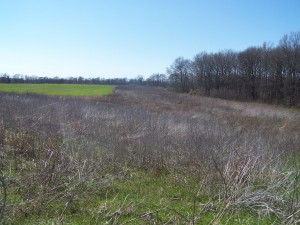
After participating in the Conservation Reserve Program (CRP) for eight years, Arkansas farmer, Walker Morris, has seen an increase in bobwhite quail and other wildlife on his land.
Walker Morris, a landowner near Earle in Crittenden County is doing his part to increase the bobwhite quail population in northeastern Arkansas. In 2007, Morris took 113 acres out of production and enrolled the land in the USDA Farm Service Agency (FSA) Conservation Reserve Program (CRP).
Of the 113 acres enrolled, Morris devoted 65 acres to riparian forest buffers, a strip of trees bordering perennial or seasonal streams that help filter nutrients from runoff, trap sediment, cool water temperatures, stabilize stream banks and sequester carbon. The remaining 48 acres were used to establish wildlife habitat for upland birds on the edge of crop fields. The field borders were planted with native warm season grasses and forbs along with interspersed shrub clusters of American plum and sumac.
CRP, which is celebrating its 30th anniversary in 2015, is among the largest private lands conservation program to reduce soil erosion, improve water and air quality and provide wildlife habitat.
It is a voluntary program that allows eligible landowners to receive annual rental payments and cost-share assistance to establish long-term, resource-conserving covers on eligible farmland throughout the duration of their 10-to-15-year contracts.
Prior to participating in CRP, Morris’ land was planted to soybeans. He occasionally spotted a covey of bobwhite quail on the perimeter of the field as birds strayed from their limited habitat on adjacent land.
Over the last eight years, Morris has seen a surge in bobwhite quail nesting and brooding on the property along with many deer, songbirds and predators.
“We are seeing an increase in wildlife of all types,” Morris said. “While we are focused on bobwhite quail, anything we do to enhance their habitat on the farm greatly benefits all wildlife.”
Morris plays an active role in managing his land by following a prescribed burning rotation. He also does some strip disking, sprays herbicide to control unwanted weeds, interseeds to promote new plant growth, plants bushy cover, establishes wheat food plots and traps predators.
He also has some row crops in fields bordered by CRP strips which are a great benefit to bobwhite quail brooding chicks. The row crops provide bare ground so the chicks can feed on insects during their first few months of life.
“We would see a significant increase in wildlife of all types in this area and at very little cost to the landowner if more farmers participated in CRP,” Morris said. “The CRP payments I receive are comparable to the income I was getting from the land when it was farmed.”
During a recent walk around the farm, Morris and David Graves, a private land biologist with the Arkansas Game and Fish Commission, set up several call-back stations and heard many calls from bobwhite quail.
“This was extremely exciting,” Graves said. “The bobwhite quail population on Walker’s property have definitely benefited from the variety of conservation practices implemented on the farm.”
Since being established on December 23, 1985, CRP has helped prevent more than 8 billion tons of soil from eroding and protected more than 170,000 stream miles with riparian and grass buffers, more than 100,000 acres of bottomland hardwood trees, nearly 300,000 acres of flood-plain wetlands, and 250,000 acres each for duck nesting habitat and upland bird habitat.
2015 marks the 30th Anniversary of CRP. For an interactive tour of CRP success stories from across the U.S., please visit the FSA CRP 30th Anniversary website at http://www.fsa.usda.gov/CRPis30.






2 Responses to CRP Boosts Bobwhite Quail Population in Arkansas